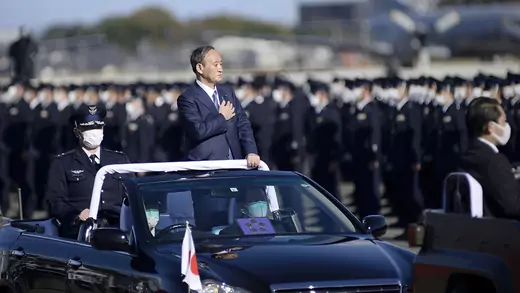By Sheila A. Smith
Prime Minister Yoshihide Suga intends to continue Japan’s sweeping upgrades of its defense capabilities amid a major buildup of China’s military forces, increasing pressure from North Korea’s growing missile arsenal, and continued activities by Russia’s military in East Asia.
But Suga’s efforts, including boosting the military’s budget, could have to compete with other domestic priorities as he struggles to bring Japan out of the COVID-19 pandemic.
How much does Japan spend on its military?
The Ministry of Defense’s budget for fiscal year 2021, which begins in April, is expected to be around $51 billion, growing for the ninth year in a row.
In 2019, Japan ranked eighth in global military spending, but relative to other countries, it spends a small share (1 percent) of its wealth on its military.
How did Prime Minister Shinzo Abe boost Japan’s defenses?
Much of the credit for upgrading Japanese defenses belongs to former Prime Minister Abe. With almost eight years in office and a supermajority in the lower house of the National Diet, Abe implemented an unprecedented series of security reforms.
In 2013, Japan announced a new national security strategy, and in 2018, it adopted a ten-year defense plan and a midterm procurement plan to realize it. Perhaps Abe’s most significant, albeit controversial, move was reinterpreting Article 9 of the constitution to allow the military, the Self-Defense Forces (SDF), to cooperate with foreign militaries to protect Japan. New security laws that passed the Diet in 2015 encountered considerable protests from opposition lawmakers and the public.

Japanese Prime Minister Yoshihide Suga reviews troops at a SDF air base in November 2020. David Mareuil/Pool/Reuters
After years of stagnation in military spending, the SDF was overdue for upgrades in air and maritime defense systems. New advancements by Japan’s neighbors have also spurred calls for investment in space and cyber capabilities.
Additionally, Japan is working to improve the competitiveness of its technology sector. The establishment of the Acquisition, Technology, and Logistics Agency within the Ministry of Defense created incentives for Japanese companies and university-based researchers to enhance competitiveness in new military technologies. Japanese defense companies also now compete abroad for military sales.
What role has the United States played in Japan’s military reforms?
The Abe cabinet worked closely with two U.S. administrations to withstand growing regional pressures. During the Barack Obama administration, the countries created a new alliance coordination mechanism after China’s deployment of maritime law enforcement vessels around the Senkaku/Diaoyu Islands raised fears of a military clash. Obama was the first U.S. president to declare that Article 5 of the bilateral security treaty covered these remote islands, clearly signaling that any attempt to use force would trigger a combined U.S.-Japan response. Presidents Donald J. Trump and Joe Biden made similar statements, demonstrating that the United States sees the East China Sea dispute as a potential flash point.
In addition, the United States and Japan agreed to improve ballistic missile defenses, prompted largely by North Korea’s 2017 demonstration of its missile capabilities. Modernization of Japan’s air defenses includes investment in 104 F-35 fighter jets, as well as improvements in early detection systems. U.S. and Japanese forces are also collaborating in maritime stability operations across the region, as well as in space and cyber missions.
Will Suga continue these reforms?
Yes, Suga will build on these efforts, but he will face several challenges. The first has to do with domestic politics; Suga entered office in September, confronting the COVID-19 pandemic and its economic consequences. By fall 2021, his Liberal Democratic Party (LDP) will face a lower house election, and like many democracies around the world, Japanese voters will be evaluating their government’s pandemic response as they head to the polls.
Second, recovery from the pandemic’s economic impacts could impinge on the budget the Ministry of Defense needs to implement long-term plans.
Third, the government is working on a new National Security Strategy, as well as revising its approach to ballistic missile defense. In June 2020, then Minister of Defense Taro Kono informed the United States that Japan would not purchase the U.S.-made Aegis Ashore missile defense system, citing political and technical problems. However, Japan is also considering whether it needs offensive strike capabilities to meet North Korean threats.
No comments:
Post a Comment